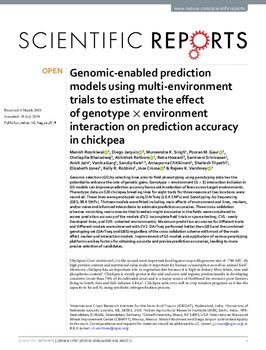Genomic-enabled prediction models using multi-environment trials to estimate the effect of genotype × environment interaction on prediction accuracy in chickpea
Abstract
Genomic selection (GS) by selecting lines prior to field phenotyping using genotyping data has the potential to enhance the rate of genetic gains. Genotype × environment (G × E) interaction inclusion in GS models can improve prediction accuracy hence aid in selection of lines across target environments. Phenotypic data on 320 chickpea breeding lines for eight traits for three seasons at two locations were recorded. These lines were genotyped using DArTseq (1.6 K SNPs) and Genotyping-by-Sequencing (GBS; 89 K SNPs). Thirteen models were fitted including main effects of environment and lines, markers, and/or naïve and informed interactions to estimate prediction accuracies. Three cross-validation schemes mimicking real scenarios that breeders might encounter in the fields were considered to assess prediction accuracy of the models (CV2: incomplete field trials or sparse testing; CV1: newly developed lines; and CV0: untested environments). Maximum prediction accuracies for different traits and different models were observed with CV2. DArTseq performed better than GBS and the combined genotyping set (DArTseq and GBS) regardless of the cross validation scheme with most of the main effect marker and interaction models. Improvement of GS models and application of various genotyping platforms are key factors for obtaining accurate and precise prediction accuracies, leading to more precise selection of candidates

